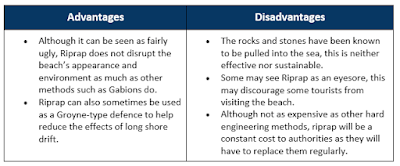Groynes-
 Groynes
are typically wooden structures however other artificial materials can be used.
These structure run from the top of the beach to the sea, they are designed to
interrupt the process of Long Shore Drift. It does this by interrupting the
sediment that is being moved along the beach by Long Shore Drift. These
structures cost around £10,000 each and must be placed at least 200m apart from
each other along the beach in order for them to work effectively.
Groynes
are typically wooden structures however other artificial materials can be used.
These structure run from the top of the beach to the sea, they are designed to
interrupt the process of Long Shore Drift. It does this by interrupting the
sediment that is being moved along the beach by Long Shore Drift. These
structures cost around £10,000 each and must be placed at least 200m apart from
each other along the beach in order for them to work effectively.
Sea Walls-
 Sea Walls are concrete wall-like structures that are
often supported by iron pilings dug into the underlying rock. They are designed
to prevent coastal erosion, they are either placed at the top of the beach to
protect areas of importance behind the beach, or alternatively, they are placed
at the foot of cliffs that are considered to be especially vulnerable to coastal
erosion such as hydraulic action. Sea Walls can be flat or curved, curved Sea
Walls deflect the incoming wave’s energy better and are therefore more
expensive than flat Sea Walls. They can cost up to £6 million to construct per
kilometre.
Sea Walls are concrete wall-like structures that are
often supported by iron pilings dug into the underlying rock. They are designed
to prevent coastal erosion, they are either placed at the top of the beach to
protect areas of importance behind the beach, or alternatively, they are placed
at the foot of cliffs that are considered to be especially vulnerable to coastal
erosion such as hydraulic action. Sea Walls can be flat or curved, curved Sea
Walls deflect the incoming wave’s energy better and are therefore more
expensive than flat Sea Walls. They can cost up to £6 million to construct per
kilometre.
Gabions-
 A Gabion is a strong wire cage that is filled with
rocks, stones and pebbles. They protect the coast by reducing the power of the
waves before that reach the cliff or coastline. Gabions reduce hydraulic action
as the wave’s strength is significantly reduced when it hit the rocks inside
the Gabion. Gabions can cost around £100 each. (Estimate)
A Gabion is a strong wire cage that is filled with
rocks, stones and pebbles. They protect the coast by reducing the power of the
waves before that reach the cliff or coastline. Gabions reduce hydraulic action
as the wave’s strength is significantly reduced when it hit the rocks inside
the Gabion. Gabions can cost around £100 each. (Estimate)
Revetments-
 Revetments are concrete, or
alternatively wooden, structures that are built along the base of a cliff. They
are slanted and act as a barrier against waves that attack the base of the
cliff. They are similar in many ways to Sea Walls. The revetments absorb the
energy of the waves, preventing the cliffs from being eroded by coastal erosion
such as hydraulic action and abrasion. Revetments can be modified so that they
have rippled surfaces, this further helps to reduce and absorb the wave energy.
Depending on the material used and the distance needing to be covered, a
revetment usually costs around £10,500.
Revetments are concrete, or
alternatively wooden, structures that are built along the base of a cliff. They
are slanted and act as a barrier against waves that attack the base of the
cliff. They are similar in many ways to Sea Walls. The revetments absorb the
energy of the waves, preventing the cliffs from being eroded by coastal erosion
such as hydraulic action and abrasion. Revetments can be modified so that they
have rippled surfaces, this further helps to reduce and absorb the wave energy.
Depending on the material used and the distance needing to be covered, a
revetment usually costs around £10,500.
Riprap-
 Riprap are
collections of rocks and stones that are placed against the base of a cliff.
Much like gabions they are designed to absorb wave energy and reduce the amount
of coastal erosion that the cliff is subjected to. They can also be
placed in front of other coastal defenses to reinforce them for example sea
walls.
Riprap are
collections of rocks and stones that are placed against the base of a cliff.
Much like gabions they are designed to absorb wave energy and reduce the amount
of coastal erosion that the cliff is subjected to. They can also be
placed in front of other coastal defenses to reinforce them for example sea
walls. 




No comments:
Post a Comment